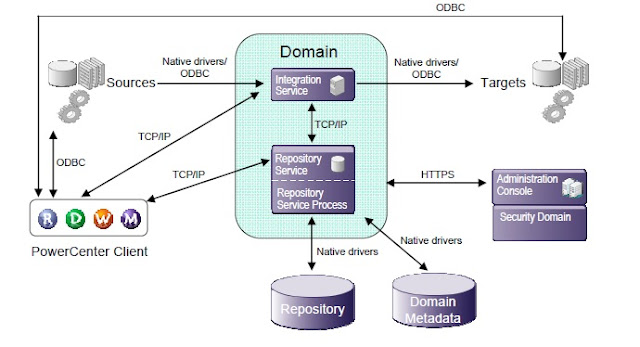Informatica Power Centre Integration Service
The key functions of Informatica Power Centre Integration Service are:
- Interpretation of the workflow and mapping metadata from the repository.
- Execution of the instructions in the metadata.
- Manages the data from source system to target system within the memory and disk.
- The main three components of Integration Service which enable data movement are,
Integration Service Process
- Load Balancer
- Data Transformation Manager
Integration Service Process (ISP):
The Integration Service starts one or more Integration Service processes to run and monitor workflows. When we run a workflow, the ISP starts and locks the workflow, runs the workflow tasks, and starts the process to run sessions. The functions of the Integration Service Process are,
- Locks and reads the workflow
- Manages workflow scheduling, ie, maintains session dependency
- Reads the workflow parameter file
- Creates the workflow log
- Runs workflow tasks and evaluates the conditional links
- Starts the DTM process to run the session
- Writes historical run information to the repository
- Sends post-session emails
Load Balancer:
The Load Balancer dispatches tasks to achieve optimal performance. It dispatches tasks to a single node or across the nodes in a grid after performing a sequence of steps. Before understanding these steps we have to know about Resources, Resource Provision Thresholds, Dispatch mode and Service levels
Resources – we can configure the Integration Service to check the resources available on each node and match them with the resources required to run the task. For example, if a session uses an SAP source, the Load Balancer dispatches the session only to nodes where the SAP client is installed
Three Resource Provision Thresholds, The maximum number of runnable threads waiting for CPU resources on the node called Maximum CPU Run Queue Length. The maximum percentage of virtual memory allocated on the node relative to the total physical memory size called Maximum Memory %. The maximum number of running Session and Command tasks allowed for each Integration Service process running on the node called Maximum Processes.
Three Dispatch mode’s – Round-Robin: The Load Balancer dispatches tasks to available nodes in a round-robin fashion after checking the “Maximum Process” threshold. Metric-based: Checks all the three resource provision thresholds and dispatches tasks in round robin fashion. Adaptive: Checks all the three resource provision thresholds and also ranks nodes according to current CPU availability
Service Levels establishes priority among tasks that are waiting to be dispatched, the three components of service levels are Name, Dispatch Priority and Maximum dispatch wait time. “Maximum dispatch wait time” is the amount of time a task can wait in queue and this ensures no task waits forever.
A .Dispatching Tasks on a node
- The Load Balancer checks different resource provision thresholds on the node depending on the Dispatch mode set. If dispatching the task causes any threshold to be exceeded, the Load Balancer places the task in the dispatch queue, and it dispatches the task later.
- The Load Balancer dispatches all tasks to the node that runs the master Integration Service process.
B. Dispatching Tasks on a grid,
- The Load Balancer verifies which nodes are currently running and enabled
- The Load Balancer identifies nodes that have the PowerCenter resources required by the tasks in the workflow
- The Load Balancer verifies that the resource provision thresholds on each candidate node are not exceeded. If dispatching the task causes a threshold to be exceeded, the Load Balancer places the task in the dispatch queue, and it dispatches the task later
- The Load Balancer selects a node based on the dispatch mode
Data Transformation Manager (DTM) Process:
When the workflow reaches a session, the Integration Service Process starts the DTM process. The DTM is the process associated with the session task. The DTM process performs the following tasks:
- Retrieves and validates session information from the repository.
- Validates source and target code pages.
- Verifies connection object permissions.
- Performs pushdown optimization when the session is configured for pushdown optimization.
- Adds partitions to the session when the session is configured for dynamic partitioning.
- Expands the service process variables, session parameters, and mapping variables and parameters.
- Creates the session log.
- Runs pre-session shell commands, stored procedures, and SQL.
- Sends a request to start worker DTM processes on other nodes when the session is configured to run on a grid.
- Creates and runs mapping, reader, writer, and transformation threads to extract, transform, and load data.
- Runs post-session stored procedures, SQL, and shell commands and sends post-session email.
- After the session is complete, reports execution result to ISP.
- Pictorial Representation of Workflow execution:
A PowerCenter Client request IS to start workflow
IS starts ISP
ISP consults LB to select node
ISP starts DTM in node selected by LB








Mastech InfoTrellis - Data and Analytics Consulting Company extending premier services in Master Data Management, Big Data and Data Integration.
ReplyDeleteVisit for More : www.infotrellis.com
Thanks for your blog. Really informative post. I hope i will find more interesting blog from you. I also like to share something interesting
ReplyDeleteinformatica Training in Bangalore
informatica Training in BTM
Amazon web services training in bangalore
devops training institutes in bangalore
data science classroom training in bangalore
tableau training in bangalore marathahalli
Thanks for your blog. Really informative post.
ReplyDeleteinformatica course
https://onlineitguru.com/informatica-online-training-placement.html
ReplyDeleteIt is very useful information for a tech support, thank you for giving such significant info about the CPU.
Apart from this, there may be more problems with the computer, so for that, I would like you to take our help,
we have helpline support which is the only stop for all your software and hardware problems.
for more detail please visit us on our website given below:-
Helpline Support US
Digital Transformation in India: A Landscape of Growth
ReplyDeleteIndia's business landscape is undergoing a rapid digital transformation. Companies are adopting digital transformation services to optimize operations, enhance customer experience and gain a competitive edge. These services encompass a wide range of solutions ranging from cloud migration and data analytics to mobile app development and automation.
Unlocking Efficiency: The Power of System Integration Services
ReplyDeleteSystem integration services refer to the process of combining various technology systems, software applications, and resources into a cohesive and unified form within an organization. The goal of these services is to streamline business operations, enhance efficiency, and improve communication and collaboration across different departments and systems. System integration involves linking disparate systems together to enable seamless data exchange and workflow automation, ultimately helping businesses leverage technology to achieve their strategic objectives.
System integration services involve the process of connecting various disparate IT systems and software applications within an organization to ensure seamless communication and data sharing. This involves integrating hardware, software, networking technologies, and other components to create a cohesive and efficient system. System integration aims to streamline operations, improve productivity, enhance data accuracy, and facilitate better decision-making by enabling different systems to work together harmoniously. It often involves tasks such as data migration, application integration, API development, and customization to meet specific business needs. Overall, system integration services play a crucial role in optimizing organizational processes and leveraging technology to achieve strategic goals.
ReplyDelete